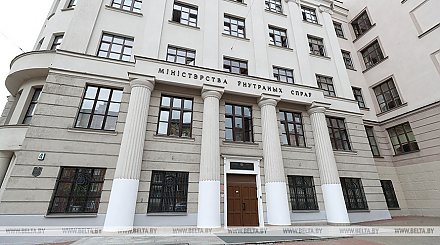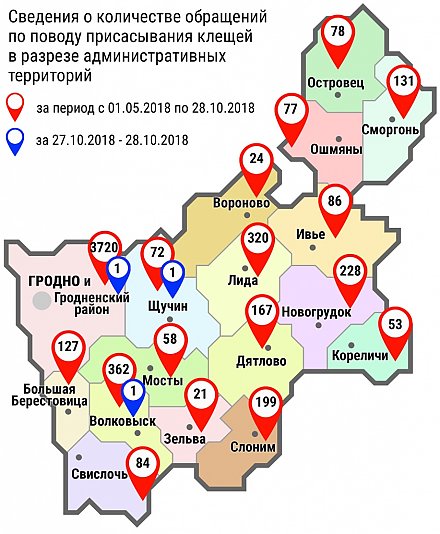Glacier tracks, a chain of six lakes. Guide to nature reserves of local importance in the project "Grodno Region: Reserved World"
The diversity of plants and animals that has developed here is also under special protection.
Hills and ridges from the time of glaciationThe local nature reserve «Alexandriyskie Pogorki» is located in the eastern part of the Voronovo district, near the border with Lithuania. This is a unique natural landscape complex that covers over a thousand hectares. Terminal moraine hills and ridges were formed during the last Sozh glaciation about 220-130 thousand years ago. The reserve is especially interesting for ecological educational tourism being an example of the most typical landscape of the northwestern part of the Oshmyany Upland.
The diversity of plants and animals that has developed here is also under special protection. In the forest with a variegated species composition, dense spruce forests with rich herbaceous vegetation are of the greatest conservation value. Two species of wild plants of the Republic of Belarus grow in the Alexandriyskie pogorki reserve: The martagon lily and Lathyrus laevigatus included in the Red Data Book grow here.

Poozersky glacier traces
The landscape reserve «Stefanetskie pogorki» was declared on the territory of Voronovo district in 1997 to preserve the natural landscape complex in its natural state, to protect rare forest complexes. It is located in the northwestern part of the region and now, after transformation, occupies an area of about five hundred hectares. The reserve is unique for the natural forms of relief that are quite rare for the territory of Belarus. This is the standard of the relief of the terminal moraine formed by the flow of melted glacial waters. In the most elevated part of the reserve, there are tracts of moraine upland, where hills alternate with ridges having smoothed, sometimes flat peaks. Absolute heights range from 180 to 210 meters.
Experts have counted 273 species of plants and 70 species of wild animals In the reserve. The abundance of strawberries, blueberries, lingonberries, raspberries is impressive here. And according to the types of medicinal plants, these are real healing pantries.

Aeolian heights, transit between forests
The nature conservation landscape reserve “Druskeniki” appeared in Grodno region at the end of 2016. A site with an area of more than 5.7 thousand hectares is classified as a specially protected natural area of local importance. It serves to preserve the biological diversity of valuable natural and plant complexes, including raised bogs, coniferous and small¬leaf forests on raised and transitional bogs, as well as the integrity of a hilly¬wavy water-glacial landscape with lakes, aeolian ridges. The landscape is unique, some aeolian formations rise 10-15 meters above the surrounding area.


Among the plant diversity under special protection are grasses and shrubs, mosses and lichens, adapted to the lack of moisture in sandy areas. This fact along with the security regime in the reserve itself is to the liking of wild animals.

Century oak trees and island on the lake
Landscape reserve «Razdory» with an area of 255 hectares is located in the southwestern part of Ivye district in the valley of the Neman River. Its notable features are landscape complexes of the water¬glacial lowland and the valley of the Neman River, large natural ash and oak forests with century¬old trees, blueberry and bracken pine forests, in which individual pines have been growing for 130 years. The Neman flows along the border of the reserve, and there are oxbow lakes inside the reserve. The largest lake has not lost its connection with the river yet.


There is an island with an area of about a hectare in the center of the lake. It is an important habitat for wetland animal species. There are such species as elk, roe deer, fox, marten, weasel and others. 90 species of birds have been registered here. Bear leek or wild garlic, listed in the Red Book of the Republic of Belarus, grows on the territory of the reserve. The reserve also serves to preserve spawning grounds for pike, bream, pike perch and other valuable fish.

Two hundred thousand years ago
In 1997 after the government decree “On expanding the network of protected natural areas” Korelichi district executive committee accepted the proposal of geologists from the Academy of Sciences of the Republic of Belarus and gave the territory of 140 hectares the status of a landscape geologist¬geomorphological and paleontological reserve. Scientists have determined the geological age of the formation of the terminal moraine relief here. It is 220-150 thousand years. It was formed during the Sozh glacier; the geological age of ravines is 14-10 thousand years and dates back to Poozersky glacier.
The traces that the glaciers left behind remain to this day, and the territory marked by them retains the status of a specially protected area. The landscape reserve «Gorno-Rutkovskie ovragi « serves to preserve the unique biological and landscape natural diversity.

The glacier left a mark
The landscape reserve «Turkish Ridges» was created in Korelichi district to preserve the biological and landscape diversity in 1997. It was when the district executive committee accepted the proposal of the Institute of Geological Sciences of the Academy of Sciences of the Republic of Belarus and gave the territory of 150 hectares the status of a landscape geologist¬geomorphological reserve. Scientists have determined its geological age – 220-150 thousand years from the time of the Sozh glacier. Of particular interest for science are terminal moraine formations unusual for the relief of Belarus. They were formed directly by glaciers during their movement and exaration. Among them are accumulations of quaternary sand, sandy loam, loam, pebbles, boulders and other rocks in the form of arcuate ridges brought and deposited by a glacier in its lower part. The study of the traces that the glaciers left behind, gives an idea of the composition of the earth's crust, make it possible to understand the geological processes that took place in it.

Two hundred meters above sea level
The landscape reserve of local importance «Borkovsky terminal moraine massif» was created in Slonim district to preserve the characteristic forms of the terminal moraine relief that is made up of formations of the times of the Sozh glaciation. The highest point of the district is located on the territory of the reserve. Its absolute mark is 223.6 meters above sea level.
The sediments which form the massif were squeezed out from under the glaciers in the direction of the interband zone. Over time, the slopes of the formed piles and ridges closer to the peaks were covered with forest, and the watershed parts began to be used by people for arable land. The territory of the reserve is approximately 3.5 kilometers from north to south, and up to three kilometers wide. Picturesque landscapes of the Novogrudok Upland open from the western slopes of the Borkovsky massif.

Unique landforms
The reserve «Zagoryevsky terminal moraine massif» was created in Slonim district in order to preserve the characteristic forms of the terminal moraine relief which was formed about 220¬150 thousand years ago during the time of the Sozh glacier. Scientists believe that once there was a corner zone of the edge of the glacier on this territory and small shifts in the position of the glacier took place. Unique relief forms were formed as a result of the squeezing out of glacial and moraine rocks from the sides of adjacent glacial tongues. Small hills are grouped in the central part on a flat plateau. Its height in relation to the neighboring areas and valleys of the Shchara river reaches 50 meters. Spruce and coniferous forests grow on the slopes of the massif, which determines the nature of the flora and fauna. A beautiful view of the wide and picturesque valley of the Shchara river opens from the eastern slope. The total area of the landscape reserve of local importance «Zagoryevsky terminal moraine massif» today is 1240.6 hectares.

Ancient celestial necklace
As many as six lakes, elongated in one line, in Smorgon district were formed as a result of melting of the glacier. The reserve “Blue Lakes” was created in 1994 to preserve in its natural state this unique lake complex within the hilly¬undulating water¬glacial landscapes. Scientists have found out the origin of this unique blue chain. Once, during the retreat of the glacier, large blocks of buried ice remained for some time on the territory. With increasing temperatures, the ice melted, the rocks lying on it sank. As a result, shallow, most often rounded, basins which were filled with water were formed.


The reserve owes to the glacier an interesting and rare for the territory of the republic landscape structure. Continental aeolian accumulations, represented by dunes, kams, elevated areas of the water¬glacial surface alternate with flat swampy low¬lying areas with sandy islands, short peat runoffs with shallow hollows. Forests on the slopes of the hollows and nearby territories regulate the water regime of the lakes. This is a fertile place for such rare plants as northern firmoss, leathery grapefern, small pasque flower, cutleaf anemone and others. From the «Red Book» birds, the common curlew was noted.
Anna Lenskaya
https://grodnonews.by/






